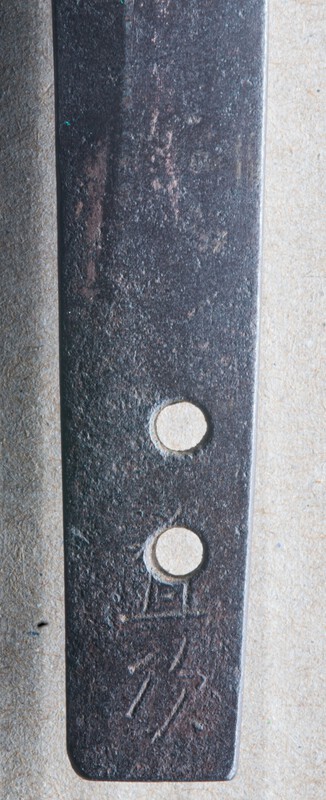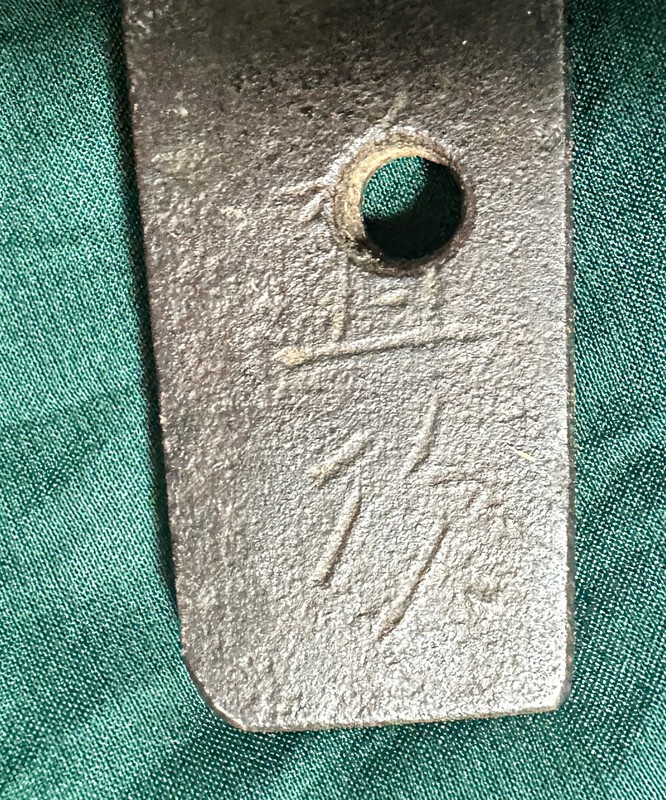-
Posts
1,983 -
Joined
-
Last visited
-
Days Won
15
Everything posted by Rivkin
-
I am bad at reading kanji, but this looks like Muneyoshi 宗榮 which can also go as Soei. The style of yasurime and patina - from Kambun to WW2 period. The problem is that yasurime and nakago generally look ok for Harima lineage, but the writing does not really match its style. Otherwise its not a common name and I don't really see any matches. On the other hand the writing itself does not scream "gimei", but its not of great quality. This is where going through books would help, there were many generations and maybe one signed like this.
-

What exactly determines the price of a nihonto?
Rivkin replied to Ikko Ikki's topic in General Nihonto Related Discussion
Absolute Savagery. Some people think they can just write a sayagaki, others think they can just write a certificate. In Russia issuing appraisal certificates for swords requires a government registration as an expert, which in turn requires a recommendation of the cultural expertise council, to be a member of which one needs to be first no less than a department head at a major museum. They would put a stop to Tanobe's shenanigans in a matter of seconds - electrodes to the balls and then eight years chopping sayagaki material... Generally, issuing opinion on a subject where one does not have a government certification as a recognized academic expert, attested by the leading members of the academia is not taken lightly there, there is a criminal article called "intentionally spreading falsehoods". -
Usually above 20k USD, in part because people are uncomfortable showing such prices, in part because they don't want someone comparing and later coming with "well you sold better blade for less money". Part of the reason these are usually sold as "reverse auction". 2 days after its posted you'll get full quote, 1 year later the price drops without making a fuss about it. Yes, the top buyers often are paying a bit more for the right being the first to whom the offer is made.
-
I'm just going to state what I think. I am sorry it will sound rough. NBTHK holds Uda Kunimune in a bit higher regard than say Tomotsugu. If it writes Tomotsugu its late Muromachi, if its Kunimune it can be on the edge between Nanbokucho and Muromachi and generally hamon can have decent work in nie. One usually goes for TH to "confirm" its Nanbokucho. I don't want to check, lazy, but then you have Kunifusa which they give to good early Muromachi Uda with tight itame and there are couple of other Muromachi names. This being said in kantei they are all considered Muromachi by default and atari to each other. This one is clearly late Muromachi, not Nanbokucho, so it has to be NTHK papers. NTHK works differently in a sense they give a name + date so they can have anydate Kunimine - early, late etc.. Nevertheless, this example has very uncommon for Uda nakago, its hadamono with weak hamon suffocated by hadori. Late uda will have rough hada and coarse, nie based hamon. I suspect this is post 2021 NTHK or NTHK NPO papers with a Strange Attribution.
-
Are papers NTHK?
-
Generally I would not feel strongly about declaring someone at this level a gimei, but even without hitting the books the signature is very condensed on one side though it uses only a portion of the nakago. Its not condensed on the other side, where fewer kanji occupy about the same length. It is filled with strokes which are miniaturized, weak and angled, a generally poor calligraphy unworthy of a serious shinto smith. Yes, I would vote for gimei.
-
I am not really knowledgeble on tosogu but is not 1800 a bit early for this execution? It looks inline with a lot of Japanesque metalwork from 1900.
-
That looks like Fukuoka modern fake with yakuza papers. As is often the case, the man who faked Kiyomaro did not have the skill to produce varied nie crystals including of relatively large size. Therefore his hamon despite having nie looks very much "blue" even when the light is almost above the blade. If the light is on a side of the blade nie hamon is supposed to look blue-grey, but when it moves above the blade its supposed to sparkle white. It does not happen with Ikkansai Yoshihiro and quite a few others from late shinshinto to early gendai who tried to make Soshu blades with apparently relaxed hardening conditions.
-
Markus did exceptional service to the community with his books.
-

Well, at least the tsuba looks okay...
Rivkin replied to John C's topic in General Nihonto Related Discussion
... I guess condition is unusual. I was involved once in a rough evaluation of Reich chancelorie and department of foreign affairs properties taken by the Soviet Union. Nothing appeared terribly interesting, mostly modern-Meiji things, actually there was considerably more Chinese pottery and decorative paintings (in 1920s there was a lot of back and forth gift exchanges) with the emphasis on pretty. There are plenty of personal/diplomatic Asian gifts everywhere, they are just not spectacular and more often than not budget friendly. -
Very aggressive koshi-zori curvature may be not too consistent with Masamune style. Out of polish Muromachi blade is suspected. Overall almost nothing of sword value has been exported from Japan before Compton's time. Even MFA collection held in very high regard when you handle the blades, they are big names but aside from one or two pieces are lesser works. It is not at the level of high end modern private collections. Until almost now having foreigners to take good old blades out of Japan was considered unthinkable. In 1900 aside from junk and soft metal tosogu, even high class, it was just not happening. Plus collectors back then knew nothing. Even today its still very much a sensitive issue.
-
I do own kozuka with this scene. NTHK papered it to Goto Kakujo and overall I have shown it to quite a few people and the opinion was that its either mainline Goto or founders of Kaga Goto, about the same period. I've spent some time looking at yahoo's listing and convinced myself mine's quality "might be" a "little bit" better which is mostly visible in hair and mons - in mine you can better see the black lines and slightly less flat execution. Yes it's Goto, but which generation is going to be random.
-
Thank you. Yes, Norishige's boshi can be quite distinctive and #1 is more or less a typical one. Regarding the #2, its funny if not crazy to say this when looking only at boshi, but I had a blade with a very similar one, which was judged as something-Tensho by NBTHK in 2010s, but Tanobe sensei thought it was late Nanbokucho Soshu. After looking at it for a very long time I convinced myself it was actually shinshinto by a follower of Ikkansai Yoshihiro - swordsmith who is seldom mentioned, but I think was prolific in his influence and his interpretation. In 1960s it was appraised by some people as early Soshu.
-
Maybe if you show the full resolution section from the last two photographs where everything is in focus or otherwise have a well lit, in focus pictures of the hamon with a light source on the side (left or right) - in the first photographs it comes from the hamon's side in which case you can't see the hamon itself. Nevertheless - its something that wants to be Rai, but is not Rai. It feels certainly late Muromachi or later. Just hamon's width per se (its wide) is ot really consistent with earlier work, among other things. It could be late Muromachi Kaga, Bizen Kiyomitsu or a few other things but I don't think so for couple of reasons. It feels a bit more Edo period. Its probably not mainline Hizen because for Hizen this is an uncommon boshi. Nevertheless I think there is a strong Hizen influence - broad nioguchi, broad hamon, dense and uniform hada. I suspect its a nice sword overall. But all of it is a sort of wild guess based on such poor photos.
-
Well, these look like Soshu boshi. They are close enough to Yamato hakkikake but are much more complex. The images unfortunately are not fantastic and low resolution. Otherwise one could actually make some conclusions about the blades. The image quality is just not there. If one still has to guess, I would put the first blade above the second. I don't see large nie crystals in the second case, everything more or less the same in size. Generally very fine lines that are drawn as if by hand is a sign of later work. First one can be lower grade Norishige that has been poorly photographed. Second I would go into Gassan Sadakatsu territory.
-
Looks like ubu wakizashi, I would guess shinto. Unfortunately, with this period its hard to go to any more specific school attribution unless in full polish etc.
-
If its ubu then the nakago can be the decisive factor. Otherwise strong utsuri and tired spots close to shinogi which are consistent with Kongo. Also Kongo often have long-narrow kaeri compared to mainline Yamato, though I don't think its seen here...
-
I suspect some good and pre-1340 stuff. Yamato Taima or Tegai Kanenaga.
-
I see an interesting blade with shirake utsuri, ko itame, possibly masame in shinogi-ji (unclear), mostly nioi based hamon with a little bit of ko nie, with some unusual forging within it, but I would not call it mokume. Its a good photo, and I always enjoy guessing what it might or might not be by just one photo with activities. To me it looks like post-Kamakura work of some ambition, most likely late Muromachi-Tensho period....or maybe shinshinto?
-
It has certain late/Muromachi shinto vibes, and probably more of the latter - wide hamon which in places is very periodic, not much else seen so far (yes, its very much out of polish), boshi and sugata would be very helpful.
-
Below: Sadakatsu versus Masamune, I did not process either image to the fullest yet. As with most shinshinto and especially gendai which carries some study of Ikkansai Yoshihiro's approach - Sadakatsu's "Masamune" will have only small nie which does not sparkle too much and all forging lines are going to be pristine and well defined. Masamune will have at least two fukure, everything will be three notches brighter, nie size will be all over the board, transitions much more natural and irregular.
-
Deep fresh cuts, distinctive triangular strikes, likely no earlier than shinto. Which leaves two guys in the book (Sesko): TOMOMITSU (友光), Genroku (元禄, 1688-1704), Dewa – “Tomomitsu” (友光), Amaya family (天谷), he lived in Iizuka (飯塚) in Dewa´s Tsuga district (都賀郡) TOMOMITSU (友光), Shōwa (昭和, 1926-1989), Nagano – “Tomomitsu” (友光), family name Kamihara (上原), he worked as guntō smith, ryōkō no retsu (Akihide) Can be the second gentleman, but it works better with seeing the blade/activity.
-
Gunto with leather over traditional saya.
-
I picked up a blade which is pretty out of polish but in hands looks like Naminohira with ko-kissaki: utsuri, wavy coarse nagare which runs in a "pack" above the hamon, hamon in nie with Yamato style activities. The only thing which is not Naminohira-like to me is that the hamon is strongly in nie and is better than most Naminohira examples which tend to lack fine grained nie. Unfortunately the second kanji looks like tsugu, the first one I can't decipher... Any help will be greatly appreciated.
-
Thank you, as a proud dumpster diver I traded/bought without papers 95% of it. There are some old continental tsubas that were not on the table. The habaki is a part of koshirae which comes with two opinions: 1. By "all-American old school shinsa of tsuba and tosogu": in suite mainline Goto, too unusual to be more specific, custom order. 2. By an "honorary Russian shinsa of crafts and blades": a combinations of pieces, all by different Goto makers. Only one piece he identified as early mainline Goto, the rest in his opinion are three (!) different generations of lesser skill. Here are the detailed examples, unfortunately the o-kozuka did not come out perfectly in focus. O Kozuka Kurigata Kojiri Kojiri2 Habaki1 Habaki2













